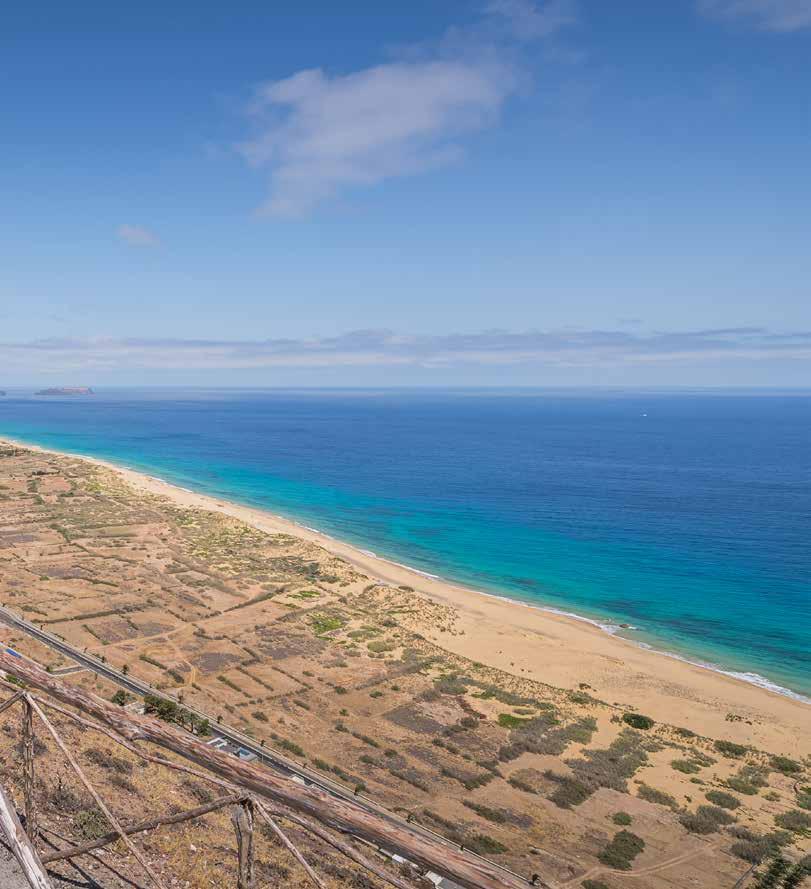








I believe I am in a paradise of enchanted fairies and eternal poetry.
One can’t imagine a better reception for a poet!
Álvaro Valente
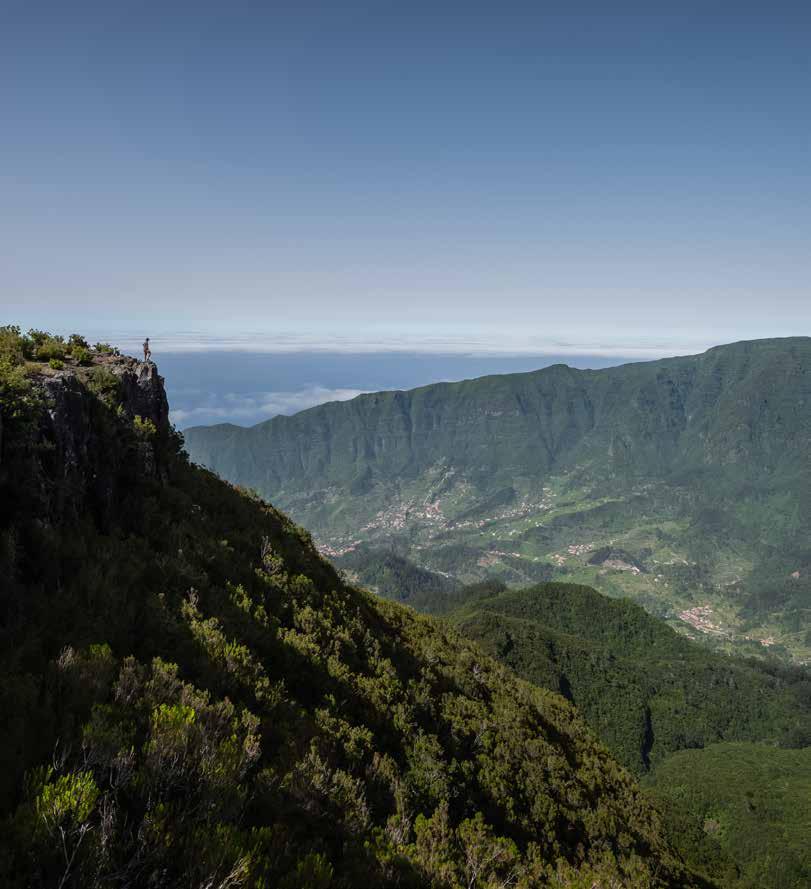
There are many ways to make the Autonomous Region of Madeira known. These Atlantic islands allow for multifaceted views, thanks to the beauty of their landscapes, the richness of their heritage, the diversity of their traditions and the strength of their people.
Porto Santo and Madeira have been an example of resilience and courage, of openness to the world, a place of arrivals and departures, a place of enchantment and discovery, for six centuries.
Therefore, this book aims to reflect a comprehensive vision of this increasingly sought-after archipelago, combining words, images and new technologies, making it possible to go deeper into the knowledge about these lands where the Portuguese arrived in the 15th century and where the world arrives every day in search of tranquillity, culture, peace and joy.
The insular world is polysemic. And it is that polysemy of contents, meanings and experiences that this book aims to bring to life.
May readers enjoy the text and be delighted with the breathtaking photographs. May readers take away with them a little of what the Autonomous Region of Madeira can offer: History, Geography, Economics, Art, Science and the Future.
These are our islands, and we are proud to invite you to come in, sit with us at the table and enjoy everything we have, but above all, everything we are.
‘Enchanted’ – because that’s what the islands of Porto Santo and Madeira are like – it is therefore a dynamic book, a book that allows us to go beyond, make new discoveries, live new adventures. A book to take, to revisit and to contemplate.
Miguel Albuquerque President of the Regional Government
of Madeira

A tourist destination of excellence, the Autonomous Region of Madeira presents itself, above all, as an affective place that wants to be part of those who know it.
Those arriving on the islands of Porto Santo and Madeira are invited to let themselves be enchanted by the beauty of the mountains, the mystery of the sea, the mildness of the climate, the richness of their culture, the diversity of their heritage, the warmth of their people, the joy of the streets, and the experience of a cuisine that combines land and ocean. Those who live on these islands know their strength and richness, know the land and the sea and know that, beyond the horizon, there is a whole world to discover.
This book aims to offer a journey throughout these lands, which have more than 600 years of History and give the best they have to offer: their identity, their genuine way of being and welcoming, their special way of making everyone (residents and visitors) feel at home.
Bringing back the idea of paradise that the ancient people placed in the middle of the Atlantic, on route to the mythical islands, but also of an archipelago where courage and will, combined with the universal vocation of all islanders, have transformed the region into a place where it is possible to be happy, ‘Enchanted. Madeira. Porto Santo ‘allows the reader to navigate, in a new and dynamic way, through words and images, over unknown places, possibilities capable of igniting the desire to visit the Archipelago, to return there, to stay there, to belong to it.
On the other hand, the access to the digital world makes this work a gateway to discovering what we have, what we are and what we can offer’.
Happy travelling!
Eduardo Jesus Regional Secretary for Economy, Tourism and
Culture


Our place is located on one of the curves of the sea. Sitting at the mouth of the volcano, we dare to look at ourselves as we are. We are the result of the sweat of men who came from the sea, opened up wrinkles in the earth, climbed the slopes and planted the houses in the embrace of the vines.
An island is the size of a dream. And the islander, aware of its value, becomes part of the majesty of the land. Being rock and land, it becomes a giant. He knows he can live together with fear because he survives the abyss every day. He knows that this is his place, his territory, because this is where he was planted when he was born. He knows that it was here that, in the 15th century, the first men were given the honour of being builders of new worlds, starting life between the sky and the sea, with courage and bravery, with utopia and hope.

Being an islander is a universal way of being. Our island has a passage to another island which is a passage to another. We are pages of a book that Nature has written, and that History has continuously composed and decomposed.
There are pieces of paradise scattered around. That’s what (our) islands are like. And we look forward to seeing you.



There are places that belong to us. There are places that allow us to live unique experiences that involve all the senses. The Archipelago of Madeira is such a place: enchanted.
Known as the Pearl of the Atlantic, Madeira is full of contrasts: The vast blue that bathes its feet contrasts with the basalt walls that the old volcano built and that the ancient forest painted majestically. The cliffs that fall into the sea create bays lined with pebble beaches that the tides wash away on agitated days. The houses that hang over the edge of the chasms and the terraces (or poios) conquered from the mountain humanise a breathtaking landscape.
The memory of this island sets sail on the dream of 16th century caravels, wafting with the green wind of the forest, seasoned with the old sweetness of sugar and the golden perfume of wine. It’s easy to see what enchanted João Gonçalves Zarco: the beauty, the ‘goodness’ of the earth, the water that flows from the rocks and irrigates the ground. It’s easy to see that the island’s geography was destiny: for those born in it, for those who visit it, and for those who have made it their home.
About sixty kilometres to the northeast, another island, smaller and blonder, sweeter and drier. They called it Porto Santo, because it was a place of salvation, a safe harbour for those at sea. History tells us that the adventure
of humanising a demanding place, a place of wind and drought, was in the hands of Bartolomeu Perestrelo. Tradition says that Christopher Columbus walked along the sandy beach and dreamt of the world hidden behind the horizon. Porto Santo is part of the Atlantic islands’ spell. It also belongs to us. It’s a peaceful place.
And then there are the Desertas and Selvagens islands, which give Portugal a much larger dimension. Nature lives there, unleashed. They are sanctuaries for increasingly rare species... ours as well.
In Madeira, the mountain; in Porto Santo, the beach; in Madeira, the water that plunges steeply into the sea; in Porto Santo, the blonde softness of the sand and the dryness of the air; in Madeira, the green, in Porto Santo, the gold. It is from this diversity that the landscapes of this region, which remains open to the world, are built.
The islands are the exact size of the universe, the exact size of time. They are concentrated metaphors of totality, round places, more or less open, more or less closed, depending on where you look. They are eternal lovers of the sea and the whistle of ships. Madeira and Porto Santo are like that.




In the beginning there was the island / although it is said / that the Spirit of God / embraced the waters.
Tolentino Mendonça


The island was deserted. A paradise. Perhaps it was there, in that corner of the sea, the place that the ancient people had described: Madeira’s location (and the Azores and the Canary Islands and Cape Verde) was on the route of the Fortunate Islands, the Hesperides, the mythical, paradisiacal Islands, the Islands of Love...
This idea of Eden, already brought by Frutuoso, (chronicler) encompasses the discovery and settlement of Madeira. A story of love and death is hidden in the mists that envelop the land, protecting it from the ambition of any Adam who might want to find the tree of knowledge there.
Because there was no one. Apart from references to Castilians passing through Porto Santo, or to Franciscans shipwrecked in the place that became known in Porto Santo as Porto dos Frades, nothing else indicated any previous concern with humanising the islands.
The chroniclers – Gomes Eanes de Zurara, João de Barros, Gaspar Frutuoso – tell the discovery of an island that allows for a new opening: Man and the World are closer once they find this place of fertile land, sweet air, immense possibilities, a stopover for merchants, a harbour of salvation, a source of wealth for Portugal and the whole world.
Everyone wants to participate in the construction of this new earthly paradise on the Atlantic. The [official] authors are generous in their description of the island, its beauty, the wild beauty of its mountains, the abundance and freshness of its waters, the quality of its wood, the fertility of its soil. And they introduce those responsible for this beginning: João Gonçalves Zarco and Tristão Vaz Teixeira, who, along with Bartolomeu Perestrelo, became the first donee captains of these lands.
Because it represents a locus amœnus, many authors allow themselves to go back to the old myths where gardens flourish: this is a Fortunate Island, an Island of Love, an Eden where there is not only an Adam and an Eve [the British Robert Machim and Ana d’Arfet] who, in the name of an impossible love, made the island a place of salvation – the bay receives and embraces the tired bodies of the lovers – but also a tabernacle, which guards their grave marked with a cross.
The settlers were required to overcome: land and water, mountains and distances. They were required to tame the soil, virgin of hands and hoes. They were required to tame the fire needed to plough the area and create clearings within the forests. And the land became fertile, because everything that was sown flourished, because the
climate favoured crops that proved to be worthwhile. And the wild soil turned into a garden.
The first settlers were followed by lots of people enthusiastic about this enchanted place offered by the sea. There were cronies of Infante D. Henrique’s household, especially servants and squires who acquired administrative and land powers. There were adventurers and second sons of the kingdom, people attracted by the fame of the island’s richness, outsiders who wanted to make the island their home.
The Prince understood the possibilities that land offered. And it was sugar cane that attracted wealth and sparked development: land was cleared, levadas and mills were built, the population grew and the desire for the island increased. This was, after all, the ‘great island of Madeira’ that Camões would speak of.
The 15th century marked the beginning of the affirmation of the new oceanic space revealed by the people of the Iberian Peninsula – the Atlantic. This sea, which until the mid-14th century had remained alien to the life of the European world, soon opened the doors to the world and defined new routes. The recognition and occupation of the archipelago of Madeira is one of the most important stages in this process of unlocking the world.
The History of the 15th century in the Atlantic is necessarily related to these volcanic islands, with all the new things they brought to the known world: its threshing floors, mills, wine presses and cellars, the technology that facilitates irrigation and the processing of products such as sugar cane and that make Funchal an important Atlantic business centre.
Porto Santo and Madeira become true bridges in the crossing of routes, in the circulation of people and products. With them, fauna and flora, technology and knowledge, customs and traditions, diseases and hope for a cure, circulate.
On 31 January 1533, Pope Clement VII elevated Funchal (a city since 1508) to an archdiocese, including jurisdiction over all the lands ‘discovered and yet to be discovered’ by Portuguese navigators in Africa, Brazil and Asia. From a religious and civilisational point of view, the Diocese of Funchal would accompany the transformation of economic and cultural relations between the various continents. This proto-globalisation made Funchal the first global diocese.




The universal vocation of Madeirans has been present throughout these 600 years of History, both in the way they have welcomed the world and in the way they have built the Region outside the islands, in the diaspora.
The islands of Porto Santo and Madeira served as a model of society, of the new structures generated by the captaincies, of the ways of organising and making use of productive space and of its institutional and spatial expression, which served as the basis for an intensively explored economy based on highly profitable export products. That’s where modernity was rehearsed, particularly with regard to issues concerning sugar.
An agricultural and technological revolution began in Madeira that would spread to the Atlantic area, particularly in the sugar mills, making it a pioneer in the sugar cane processing.
The islands became spaces to support ocean navigation, testing grounds for new cultures and techniques, used to the fullest in the vast lands that were later discovered.
Here, land clearing techniques were adapted to the orography of the new areas, with some ingenious solutions. In the History of Science context, the islands became ‘scientific stopovers’ in the Atlantic. They were laboratories where techniques for collecting, analysing and studying the animal and plant world were tested, serving as a bridge between the Old and New Worlds, throughout the 19th and 20th centuries. Madeira became the stage for the adaptation of colonial flora to the European continent and the madeiran estates became veritable botanical gardens that entertained patients who came in search of a cure for tuberculosis or melancholy. The island’s breathtaking beauty accompanied scientific interest. Until today.
In fact, the(se) islands were much more, because they understood their relationship with the Atlantic world and opened the way to routes and markets, finding, at every moment in their History, a way of being in the world: first sugar, then wine, what poets sang about, what kings appreciated, what Shakespeare mentioned. Many sugar cane fields have been replaced by vineyards because of it, and the scent of grapes has been allowed to enchant the summers since the 16th century. It reflects times of progress, especially during the 18th century, but also times of crisis.
The difficult political climate of the first half of the 19th century, combined with vineyard diseases, had very complex social and
economic implications, pushing many Madeirans off the island: Brazil, Demerara, Hawaii, Angola, Curaçao, South Africa and Venezuela are just some of the destinations open to Madeirans.
Meanwhile, on the islands, the women (mostly women) are trying to hold on to what’s left: the land, the house, the children, whom they often provide for with the labour of their hands.
It is the political changes that alter the course of life in Porto Santo and Madeira: first the Republic in 1910, then the dictatorship and finally the Revolution of 25 April 1974, which opened new perspectives for the archipelago. The autonomous process and April’s achievements halted emigration, developed industries, agriculture, particularly with new investments in vineyards and banana plantations, health and accessibility. There’s another perspective on education, culture and tourism.
Portugal’s accession to the (at the time) European Economic Community provided the archipelago with integrated development and brought Madeira closer to the old continent. The Regional Assembly recognised, in 1985, the advantages of the accession for economic progress and the strengthening of the island’s contribution to the creation of the community. The islands are entering a new era: that of the future.
The Autonomous Region of Madeira becomes one of Europe’s most attractive destinations. The paradise of the beginning opens up to the world: new businesses are developed, new challenges are addressed and new opportunities are created.




We pass the large island of Madeira/ Named after its many trees Camões
The heart of the island of Madeira is thus painted in green: the green of the trees, the green of the mountains cultivated in terraces. Ferreira de Castro, explaining the evolution of the greens, writes that ‹the island had ceased to be just woodland, but woodland, vegetable gardens and gardens›.
The initial forest that named the island is giving way to farmland, and the wood is being used for everyday needs. Alluvial floods and fires strip the mountains of their original green colour, and over time there was a need to take care of the landscapes, to look after the mountains, to integrate agricultural activity into the forest, to protect the Laurissilva Forest, the name by which Madeira›s indigenous forest is known. It occupies an area of around 15,000 hectares, equivalent to 20% of the island›s territory, and is essentially located on the north coast, from 300 to 1,300 metres above sea level, while on the south coast it persists in some hard-to-reach places, from 700 to 1,200 metres. It is included in Madeira Natural Park› area; it is a Council of Europe Biogenetic Reserve, a UNESCO World Natural Heritage Site and is part of the Natura 2000 Network.
Today, Laurissilva is one of Madeira Island›s landmarks and is home to plant and animal species that are unique on a global scale, as well as representative natural habitats that are important for the conservation of biological diversity.




The lymph thus flowed for kilometres to irrigate the sugar cane fields and vineyards, hortejos (small vegetable gardens) and orchards of the lowlands, which were no less thirsty for being on the edge of the ocean. Madeira’s entire economy resided in the levadas, which numbered in the hundreds. Some had remote origins: its waters had been singing softly for centuries, day and night, night and day, through the murmuring foliage and the silence of the great chasms.
Ferreira de Castro
The levadas are, in fact, the most perfect example of the Madeirans’ entrepreneurial capacity, capable of digging up the basaltic soil to divert the course of the streams to water the fields.
Built of stone and lime, the levadas are long, narrow channels that reach a depth of 80 cm and carry water from the high, central points of the island’s mountainous massif to the drier areas, especially in the south of the island.
A complex network of main and secondary levadas covered the entire island of Madeira. The Madeirans became expert builders of these water channels and took their experience to the Canary Islands, America and even Egypt. Afonso de Albuquerque even asked the king to send him Madeirans to divert the course of the Nile. There are around 2,200 km of canals and 40 km of tunnels, a titanic work on the edge of the abysses, men often suspended by ropes as they attacked the rock.
Cultivated areas and farmers’ houses line up around the levada, because it was a very important element of rural life as a place where water, people and products circulated.
The water’s movement is the result of a natural impulse due to the gradient given to the levada from its origin to the end of the turn. The volume of the flow is variable, reaching a minimum of 12 litres per second and a maximum of 30. The spring is divided into a number of secondary flows, the hauls, distributed among the branches (terraces) that irrigate various points in different areas. The water is distributed by the levadeiro who, armed with an hourglass or clock and a conch, sets the course for the day’s flow and delivers the water to each heréu (person). The space of time that elapses between two passages of water from a levada through the same land is called a giro.
Today, these waterways criss-cross the mountain and are true paths to paradise. They take you to discover the heart of the island and – on breathtaking walks – into the heart of nature.




Guindaste Viewpoint

The sea – the horizon of all islanders. Maria Lamas
The sea plays a very important role in Madeira’s History, Culture, Science and Economy. It has established itself as a privileged means of transport and a source of economic resources. Today, the Region is asserting itself as a place of the future, focusing on scientific research, ocean literacy and the blue economy.
Given Madeira’s difficult orography, the coastal transportation of people and goods was done by sea; the same happened between the islands and between them and the world. But the sea isn’t just the route that brings us closer to others, as it also provides us with countless economic resources. Along with farming, fishing was an occupation of the islanders.
In fact, the Exclusive Economic Zone (EEZ) of the Archipelago of Madeira is 200 nautical miles wide, except for the Selvagens Islands where it borders the Canary Islands’ Exclusive Economic Zone, which shows the importance of the sea and the world of possibilities it offers.
Today, the seas of Madeira and Porto Santo are much more: marine biodiversity attracts researchers from all over the world, artificial reefs repopulate the seabed and promote scientific and socio-economic development in the Region, particularly in areas such as: recreational boating, aquaculture, shipbuilding, diving and the industry that supports maritime activities.
Madeira is home to the first exclusive marine reserve created in Portugal, more precisely in Garajau, an essential place for the renewal of fish stocks on the south coast of the island of Madeira, and a tourist attraction for diving in the region, in the presence of the well-known groupers Epinephelus Marginatus, a protected species.
In 1971, the Selvagens Islands were classified as a national reserve, thus becoming the first of a series of protected areas in the Autonomous Region of Madeira. On 29 November 2021, the Regional Government announced the creation of Europe’s Largest Total Marine Protected Area (2,77 Km2, 12 nautical miles around the islands), a decision duly supported by scientific studies resulting from expeditions carried out in recent years.
Throughout the year, you can spot around 28 species of cetaceans, whales and dolphins in Madeira’s seas, as well as turtles and the monk seals that live on the Desertas Islands. Porto Santo’s economy is increasingly looking to the sea, to the transparency and richness of its waters, to the discovery of the artificial reefs that the sunken ships – the ‘Madeiran’ and the ‘Corvette General Pereira d’Eça’ – have become.
You can go to the sea all year round on the islands. With its normally calm waters, the temperature fluctuates between 17ºC in the Winter and 24ºC in the Summer, allowing Madeirans to have a very close relationship with the sea.



One of the most beautiful beaches in the world, (...) with the shape of a crescent, with the gentle slope of a pool, with fine golden sand – glistening like gold dust – bordered by silent, crystal-clear, lukewarm water.
César Pestana
On islands like ours, where the sun shines most of the year and tourism is a major source of wealth, beaches are always an attractive place. The accesses to the sea are outlined, sometimes with abrupt rocks crashing into the ocean, sometimes with pebble beaches that force those who lived by the sea to balance, sometimes with black sand coves, such as Prainha, in Caniçal, or one of the most beautiful in Europe, Seixal, on the north coast of the Island of Madeira, after the beauty of the Véu da Noiva waterfall, a place framed by the rough, green mountain that makes it magical. Right next door, the Seixal Natural Swimming Pools and the marvellous Porto Moniz Swimming Pools earned the classification of ‘Europe’s most beautiful place for a dive in the sea’ by the English newspaper The Guardian in 2017. These are natural saltwater pools formed by volcanic rocks, overlooking infinity.
On the other hand, the range of bathing services on the island of Madeira includes a variety of public and private swimming pools, bathing complexes (Lido, Barreirinha, Praia Formosa...) and clubs (Clube de Turismo and Clube Naval) that allow you to take a dive in the sea all year round.

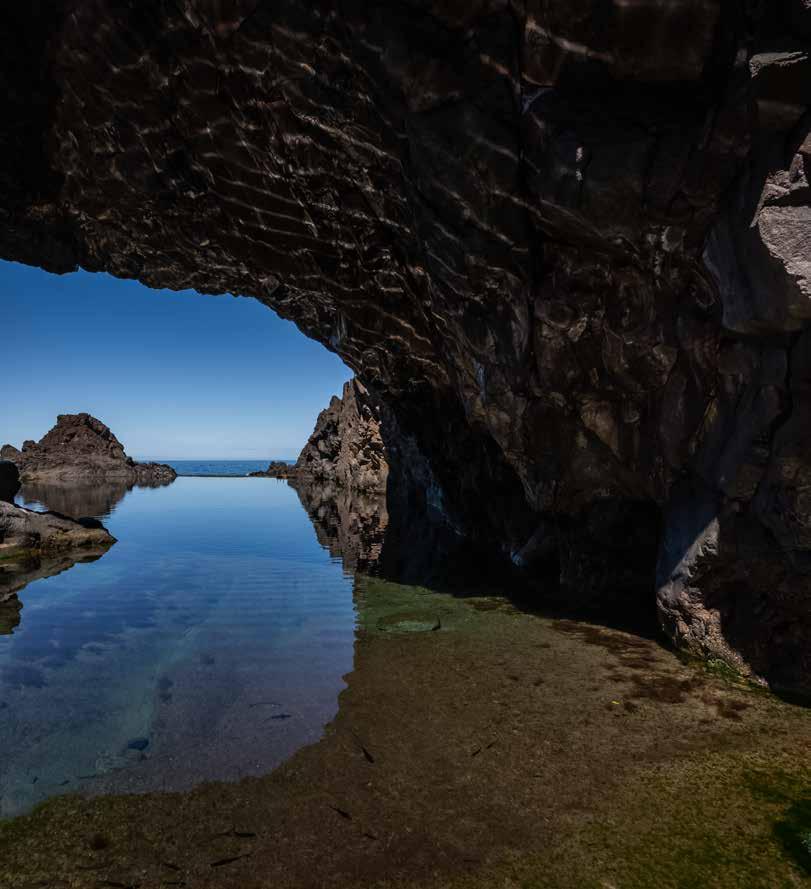


In the geography of the world, it is clearly the beach that marks Porto Santo, a wide, safe beach that gives it paradise status and is the island’s main source of tourism. In the Municipal Annals dating from 1862, there are references to foreigners’ attraction to the beach and its therapeutic effects. It stretches along the south coast for 9 km and is still the main attraction on the island of Porto Santo. Awarded the title of ‘Best Beach in Europe 2022’, its sand has unique properties. Used to treat musculoskeletal diseases, it has been called ‘Island of Health’.
visitmadeira.com
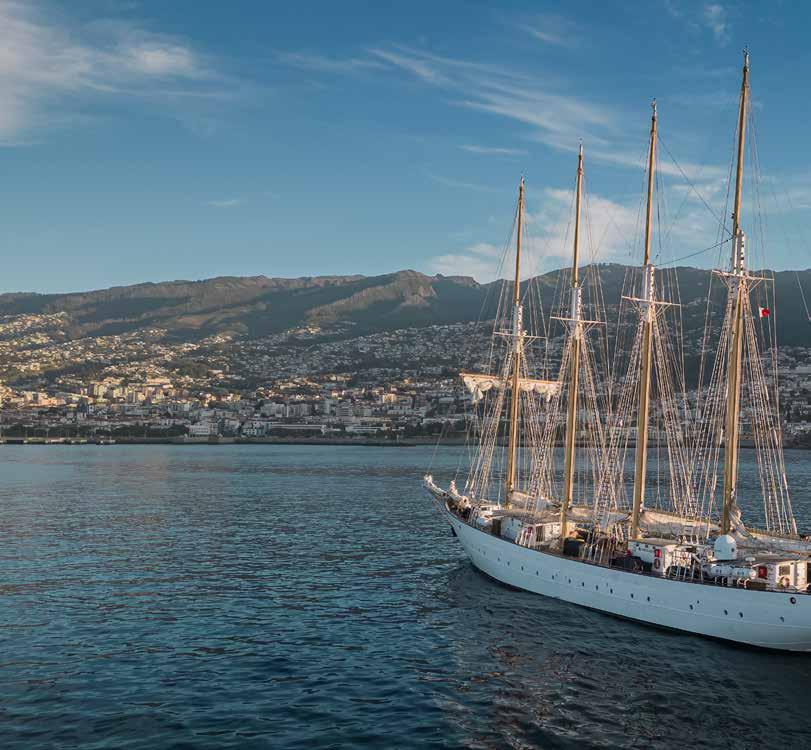

“And for all the fennel he found in ithe named it Funchal, from where he afterwards founded a town with its name”
Jerónimo Dias Leite


At the end of the 15th century, D. Manuel, Duke of Beja, began planning and organising the prosperous town of Funchal, rich in sugar and a place of business: he ordered the construction of the City Hall and of a new church that would become the seat of the diocese in 1514.
Funchal was elevated to city status on 21 August 1508. The urban fabric grew, and the increasingly popular port of Funchal attracted outsiders, including middlemen, adventurers and sugar merchants. Some monuments from this era marked by the heyday of this period remain: the Cathedral and the Customs House and the richness of Flemish paintings, mostly from the 16th century, first displayed in private chapels and now on display in the Museum of Sacred Art of Funchal.
The 16th and 17th centuries were marked by a new product which, despite the sugar industry’s decline, ensured the importance of the port of Funchal’s strategic position in the North Atlantic: wine. The city is transformed and once again committed to valuing architecture and art. Funchal becomes the city of wine. The merchants, particularly the British, transformed the townhouses into shops and offices and adapted the manor houses and quintas (Madeiran estate – a sizeable town house standing in its own garden) to their taste and comfort requirements. Chippendale and Hepplewhite sofas and chairs give them a touch of class and set the mood for soirees and teas. The Quinta das Cruzes and Frederico de Freitas museums are today the depositories of some of these most significant specimens that withstood centuries of use. The interior space is valued. The house becomes the main social centre.
Among the various buildings that the wealth from the wine helped to build, the following deserve our attention: the S. Pedro Palace, now the Natural History Museum, built as the residence of the Count of Carvalhal; the Funchal Council Chambers, also known as the Palace of Count of Carvalhal.
Many of these imposing palaces are sided by a typical architectural feature of the island a torre avista-navios (the ship lookout tower which), present in many buildings, helps to plan the city’s urban layout.
We could add to these two most significant moments in the construction of the city others closer to us that marked the city in the 20th century and made it grow: concern for people and their safety, which is often jeopardised by alluvial fans and river floods, and tourism.
In the shape of an amphitheatre, Funchal connects the sea to the mountains. Based on a heritage and cultural past of more than 500 years of History, of which the Museums that preserve its memory and the maintenance of its Heritage are representative, it is a city that looks to the future and keeps its arms and heart open to those who come from outside. It’s a cosmopolitan city that welcomes visitors from all over the world every day. The port is the Atlantic gateway to this land, whose capital bathes its feet in the sea. Its welcoming bay welcomed merchants and travellers and continues to enchant those who come in search of wealth, adventure, health, peace and fun.
Funchal is the largest tourist, commercial and cultural centre in the entire archipelago of Madeira. History and contemporaneity live together in a place that stretches from the sea to the mountains. Monuments and museums tell the stories of History. The Mercado dos Lavradores (Farmers’ Market) brings them up to date in smells and colours, flavours and textures that bring the countryside and the sea to the table.
Today’s Funchal, with more than 100,000 inhabitants, is sophisticated and beautiful. It’s a garden city planted by the sea, a must-see, a place that has learnt from its History to look to the future with hope.


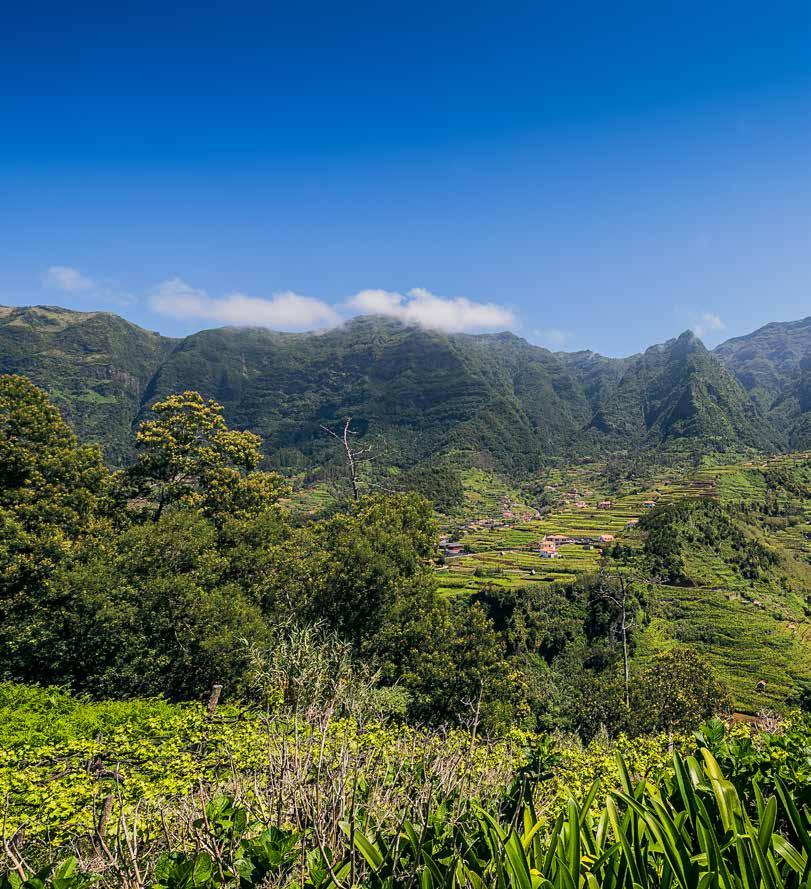

A house with distant windows / carving the basalts.
Irene Lucília Andrade
Throughout the island, other urban spaces – towns and villages – offer glimpses of experiences that make them special: Câmara de Lobos, the fishing bay that Churchill painted; Ribeira Brava, situated at the mouth of a stream that other winters have named; the picturesque Ponta do Sol, home to a large community of digital nomads in the John Dos Passos Cultural Centre, which commemorates this writer of Madeiran descent; Calheta, a place of sugar mills and the capital of contemporary art, in a building by Paulo David that blends into the mountain; Porto Moniz, which spills out into the North Sea and is known for the natural beauty of its swimming pools; the picturesque town of

São Vicente, guarded by stone giants and opening onto the sea; Santana, the thatched cottages, forest walks and freshly baked hot bread, Machico and the secret of the beginning; Santa Cruz which became the island’s gateway.
But there are more hidden mysteries: the valley of Curral das Freiras, the breathtaking view from Eira do Serrado, the sea of clouds from Pico do Areeiro, the poncha and açorda from Poiso and all the other places you need to discover.

Nearby, by boat or aeroplane, a small island hides secrets. It is clearly the beach that marks Porto Santo in the geography of the world. The epithet of ‘golden island’ is mainly due to the ‘golden beach’, despite all the other golden areas: the grainfields and the aridity.
Despite being different from Madeira, Porto Santo has been part of the Unesco World Network of Biosphere Reserves since 2020. It’s the climate, the light, the viewpoints, the boats anchored in its transparent waters, Pico Ana Ferreira and its prismatic columns, Greta da Dona Beja, Porto das Salemas, Porto dos Frades, Fonte da Areia, the colour of the sea, the mills, the golf.
Vila Baleira is the name of the city that bathes its feet in the Atlantic. There, the past and the present live together: They are the cobbled streets, the matamorras (underground grain storage), the parish church, the museums, the cafés, the summer evenings watching passersby.
With just 42 km2, Porto Santo is a sanctuary of tranquillity and peace, as if it were a desert island, with all that it represents in the imagination of those who visit it.
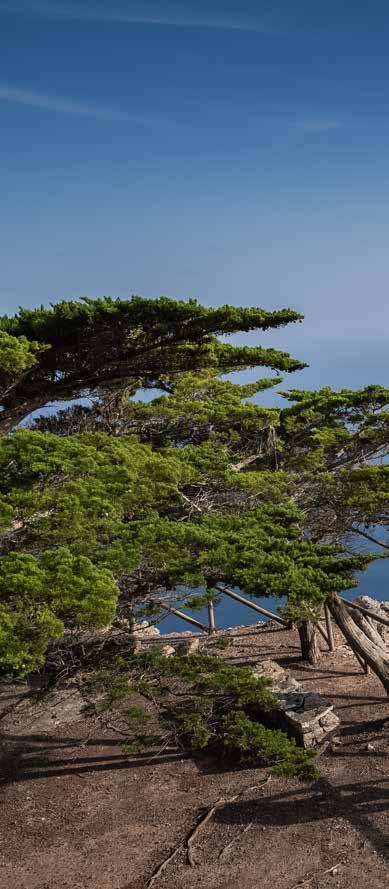



All of it is a garden and everything they harvest on that island is gold.
Cadamosto


When your eyes wander over the mountains, this is the landscape that visitors see: fields upon fields, small spaces supported by stone walls or heather hedges that divide properties, separate crops and prevent them from being pushed out to sea. The fields thus cultivated sweeten the rock’s hard shapes that rise towards the sky. They turn it green. They mark it. Each terrace represents the livelihood of many families who conquered the mountain, who hung their houses on the edge of the hills.
It is this rural and agrarian image that marks the beginnings of the island’s economy. The settlers first built the terraces (poios), then adapted the farming techniques and tools to the new cultivated area’s constraints.
Until the 1470s, Madeira was an Atlantic granary, producing cereals capable of supplying the needs of the crown and the African markets. It lost this position to the Azores, investing heavily in sugar cane cultivation, which brought the island great profits and contributed to the town’s ennoblement, later the city of Funchal. It was thanks to the sugar trade that Flemish works of art – paintings, sculptures, jewellery –
entered the archipelago of Madeira as of the second half of the 15th century and can still be seen in some churches and chapels, but above all in the Museum of Sacred Art of Funchal.
The sugar route, in its transmigration from the Mediterranean (the first cuttings came from Sicily, by order of Infante D. Henrique the Navigator, around 1425) to the Atlantic, has Madeira as its main port of call. Madeira became a major producer of the sugar that reached the tables of the biggest European houses, and the sugar loaves inspired the name of the hill in Rio de Janeiro (Pão de Açúcar), due to the shape they took. It was on this Atlantic island that technology and know-how were developed and implemented in the spaces discovered.
With the strength of the Brazilian and São Toméan markets, Madeira’s economy turned to wine, which became essential for sailors, expeditionaries, explorers and colonisers.
This alteration in the production structure led to changes in the island’s economy. For more than two centuries, wine and vineyards animated the countryside and the city, where warehouses refined what came from the wine presses.
At the height of the wine industry, Madeira begins to take on a new role in the colonial and European context and a new sector begins to emerge – tourism and the services it onsets. Attracted by business opportunities and overwhelmed by the island’s beauty, the British discovered paradise.


Madeira recreated the ancient myths of Greek literature and offered plenty of reasons for a cultural ‘grand tour’ and became (like other Atlantic islands) an interesting laboratory for scientific studies by botanists, ichthyologists and geologists, and was even considered the Atlantic’s scientific stopover.
From the second half of the 18th century, Madeira became a resort for therapeutic tourism, thanks to the prophylactic qualities of the climate in curing tuberculosis, attracting new visitors – aristocrats, politicians, poets and writers.
The first infrastructures to welcome these visitors emerged – sanatoriums, accommodations and agents, who acted as intermediaries between the

outsiders and the owners of some of the spaces that hosted them – the ‘quintas’ for example. Tourism, as we see it today, was taking its first steps and developing other parallel activities that had tourists, especially British tourists, as their main promoters. That is the case with embroidery, wickerwork and embeddings.
Today, this is the main engine of Madeira’s economy. Madeira presents itself as a quality destination that stands out for its natural beauty, the hospitality of its people, its culture and the excellence of its services, having won numerous awards for excellence, namely that of best island destination in the world.



An island (...) fully covered in dragon trees and junipers and other trees right down to the sea. Gaspar Frutuoso
In the beginning, it was nature and what it offered to Man.
When the Portuguese arrived in Porto Santo (tradition says that in 1418 and new studies in 1420), they found a place of dragon trees, lime and an abundance of fish.
In the beginning, it was nature and what it offered to Man. Porto Santo was a place of dragon trees, lime and an abundance of fish. Then, as a result of human activity, cereals, vineyard and fruit took over the fields which, due to long droughts, the invasion of sands and a certain amount of carelessness, disappeared, often leaving the island starving and despondent.
While cereals, especially wheat and rye, fulfil the mission of supplying the basic dietary needs, vineyards are a resource, as grapes and wine are in demand in Madeira. As for the other resources of the soil, the subsoil or the sea, they are just contributions that help to animate the economic life of the people of Porto Santo, keeping them attached to the land: watermelons, melons, prickly pears, bread and biscuits, water and lime.
Today, the island’s economy is mainly based on the service sector: the beach, the sands, the mineral water and the grapes transformed Porto Santo into a therapeutic resort that evolved into a holiday destination that has grown to its current level.
On 28 August 1960, Porto Santo airport was inaugurated, the first to be built in the archipelago. The initial runway, which was 2,000 metres long, was extended to 2,440 metres and, with the renovation, which began in 1986, the runway was extended to 3,000 metres, with a new passenger terminal and new technical facilities, making the airport capable of receiving all types of aircraft.
However, autonomy favoured progress, breaking down borders and barriers that seemed insurmountable. The words drought, famine, abandonment and isolation were erased from Porto Santo’s current vocabulary. New concepts emerged: paradise, marvellous, peaceful, golden, “an outdoor resort where less can be more”.




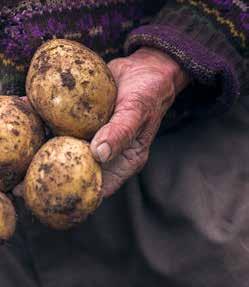


Madeirans’ hospitality is the expression of a feeling and the strength of a habit. It’s a demonstration of courtesy that is increasingly rare around the world, and it’s also a pleasure for the locals.
Henrique Galvão
The Madeirans have the world in their eyes. The sea is their estate, but the land is their place. This is a people that learned from History how to overcome land and water, mountains and distances, how to create clearings within forests and turn vacant land into vegetable gardens and gardens.
The Madeiran people were built on this connection with the world and learned the art of hospitality: traders, patients, travellers, scientists, tourists, digital nomads. They learned to use to their advantage the islands’ mild climate, the endless secrets of nature, a world of knowledge and emotions.
They learned the joy of knowing that you have to enjoy every moment that paradise offers you.
The people of Porto Santo are different. Over time, they adapted to an often harsh nature, a lack of water and a noble way of being, often mistaken for indolence and arrogance. They are a resilient people, correct, delicate, shy and proud, zealous of their lineage and their surname, intelligent and perceptive. They also see the sea as the future. And are proud to have welcomed Christopher Columbus, who also dreamt of the world there.

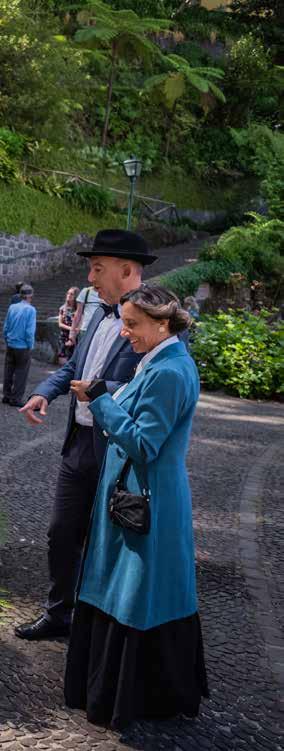
No one can set free from an island. Helena Marques
Throughout the ages, the gateways of Madeira have always been open: adventurers, explorers, politicians, kings, artists and scientists found a remedy for their illnesses on the island, a place of encounters and discoveries.
In the 15th and 16th centuries, the Atlantic provided an intricate network of navigation and trade routes that turned Madeira into a laboratory for new cultures, new techniques and new structures that were later implemented elsewhere.
During the 18th and 19th centuries, Madeira started to attract naturalists and scientists who began to see the world with curiosity, seeking answers to certain mysteries and questions. With the advent of encyclopaedism and Linneo’s classifications, the islands assumed a prominent role and Madeira became the Atlantic’s scientific centre (Vieira, 1999:30).
On the other hand, since the end of the 18th century, the therapeutic qualities of the island’s climate were publicised throughout Europe and, as a result, the number of visitors increased considerably. Several acclaimed personalities have been to Madeira – scientists, doctors, artists, poets and writers, members of the most important European royal families. They have been the main drivers of tourism, as their increasingly long stays led to the creation of support infrastructures, particularly in terms of accommodation, transport and services.
The ‘quintas’ particularly in the Santa Luzia and Monte areas, welcome many visitors, particularly the British, who come for business or health reasons.
However, from the 1930s onwards, Madeira began to prepare itself to receive tourists. William Reid and W. Wilkinson, who settled in Madeira in 1844, were the first owners of what would become the first hotel units. The Reids Hotel is currently the oldest hotel in Madeira and the entire Atlantic area and stands out as a landmark in the History of Tourism. Acclaimed personalities such as W. Churchill, B. Shaw, G. Marconi stayed there.
At the end of the 1840s, Silvestre Ribeiro, the Civil Governor, laid the foundations for the creation of a set of support infrastructures in interior of the island, the so-called shelter houses. Visitors now have places to stay in Boaventura, S. Vicente, Seixal, Rabaçal, Santana and Santa Cruz.
People from all over the world come to the archipelago, illustrious people who, with their visit, put Madeira on the map as a place of beauty, tranquillity and business opportunities. They are intellectuals and artists, poets and writers, politicians and military, high dignitaries of the Church and European royalty. And, if for the Madeirans these visits were important, for these visitors Madeira will certainly have also been a milestone in their lives, with its leisure and relaxation, knowledge and creation, and celebrations. Among


the many who have fallen in love with the archipelago, we would highlight Empress Sissi, Charles of Austria, Humberto II – King of Italy, Churchill, Cliff Richard, Omar Shariff, and Pope John Paul II. And poets. And actors. And politicians. And anonymous people who fell in love with this land.
Tourism became the main factor in Madeira’s development as from the 1960s. The construction of the airport in 1964 allowed new possibilities for the development of tourism. The new airport, which was improved over the last few years of the 20th century until it became an intercontinental runway, marked the change in tourism brought with the replacement of steamers by aeroplanes.
The importance of tourism in the island’s economy led to changes at the institutional level, with the authorities showing greater interest and commitment. Firstly, the tourism commission was set up in 1930, on 5 September 1936, arose the Madeira Tourism Delegation, then the Regional Tourism Secretariat, today the Regional Secretariat for Economy, Tourism and Culture.
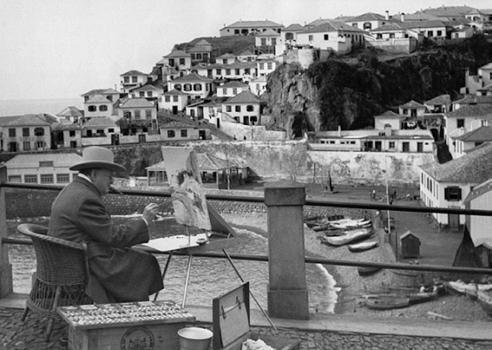



The archipelago has endless resources, extraordinary posters of colour and attraction.
The calendar is an excuse to celebrate, in the archipelago of Madeira. The good weather helps to take life outside, whether it’s summer or winter, but it’s the gentle way of welcoming people that makes the Archipelago an outdoor party hall: The New Year opens with joy, music and fireworks that light up Funchal’s bay and other parishes that welcome the New Year in festive attire.
Then there’s Carnival: Saturday’s allegorical parade and the satirical Trapalhão da Terça-feira (Tuesday) make you forget that it’s winter all over Europe and spring in Madeira.
When spring arrives, it’s the Flower Festival that brings people to the city: there are flower carpets, concerts, folklore groups in the streets, flower exhibitions, parades that show the beauty of nature, Madeira Embroidery, youth and the city; it is the Wall of Hope and the Wall of Solidarity which are true parades of beauty and elegance with the Madeira Flower Collection, the Madeira Flower Classic Auto Parade and the Madeira Classical Car Revival.

Between May and June, especially in Funchal, philharmonic bands, folklore groups and gastronomic festivals prepare the celebrations of the popular saints, Saint Anthony, Saint John and Saint Peter. These are times of many experiences: it’s the smell of holy herbs; it’s the flavour of a very particular cuisine made with tuna, beans cooked in their pods, potatoes and corn on the cob; it’s the joy of the marches that the parishes prepare and that enliven the places. Every Saturday in June, the Atlantic Festival lights up the nights with fireworks and classical music, as well as other cultural events that merge the local identity, so closely linked to the sea, with the joy of those discovering it.
The ‘Rali Vinho da Madeira’ (Madeira Wine Rally) is an international motorsport competition that attracts famous racers from all over the world and takes place in August. Other regularly scheduled events linked to classic cars, ‘Clássicos na Magnólia’ in July and ‘Rally Madeira Legend’´. in the last quarter of the year show Madeira’s wealth, which has more than two

thousand classic and vintage cars in perfect condition to be presented at public events such as exhibitions, contests and historical events, which take place throughout the year.
In the middle of summer, the ‘Madeira Saborea, a journey through taste’ Food Festival offers the flavours of the island, combining cuisine with various gastronomic routes (couscous, grass peas, seafood and molluscs, fish, conventual confectionery, fruit, tubers, and bread).
In September, we celebrate wine and the vineyard, remembering the labour of man and the joy of the people. In Funchal, live paintings serve as a frame for concerts and entertainment; you can try the grape harvest and taste the must in Estreito de Câmara de Lobos.
There are festivals throughout the year: the Organ Festival, Music in the North Festival, the Jazz Festival, the Atlantic Roots Festival and all others that serve as a pretext for singing and dancing, for eating and drinking, for celebrating life and the land’s beauty.
The Columbus Festival, at the end of the summer, is based on a series of tourist entertainment initiatives, evoking the passage of Christopher Columbus through Porto Santo and including markets, street parades, circus arts, concerts and lots of entertainment.
Nature – the greatest asset that our islands possess – is evoked in a Festival where beauty and adventure provide unforgettable experiences.
Starting in December, the Region starts celebrating. There are concerts, shows, street markets and lots of entertainment everywhere. Everywhere you go, your senses are overwhelmed by the lights, the smells, the flavours, the songs and the sensations offered around every corner.
As from 15 December, childbirth masses fill the mornings with festivities and the streets with music. Special attention should be given to the Market nights that take place all over the island and bring the tradition of shopping, Christmas carols and food and drink stalls open until dawn to the streets.
And on the 31st, as the old year ends and the new one starts, the islands burst into fireworks, parties and entertainment. A constantly celebrating Region –this is one way of presenting ourselves to the world.



The man who lives, day and night, between sea and sky, lives more with the infinity.
Ferreira de Castro
On the islands, some say, there is a greater need for faith. Between the sea and the sky, with nowhere safe to run to, the islander can only believe: sometimes in the God of the Christians, sometimes in the Universe, or the Centre, or in the centripetal force of the earth. Thus, the Christianity brought on the caravels of the Discoveries was joined by other ways of connecting the ground to the sky. Nature, in the full exercise of its powers, transforms the soul of man, who cohabits with it at all times.
It is largely the liturgical calendar that sets the pace for the festivities, which are consecrated to the Holy Spirit, Our Lady, the Blessed Sacrament or the patron saints of the parishes.
Among the most important pilgrimages are the Nossa Senhora do Monte Festival on 15 August, the Senhora da Graça Festival in Porto Santo, São Pedro, in Ribeira Brava and Porto Santo, the Senhor Bom Jesus Festivities in Ponta Delgada, the Senhor dos Milagres Festivities in Machico and the Senhora da Piedade Festivities in Caniçal.
The religious festivity is joined by the profane one: the churchyard and the streets through which the procession passes are decorated, and flower carpets cover the ground.
It should be noted that the procession is part of all the island’s festivals. Walking is going on a pilgrimage to the centre of the world. At every festivity, people sacralise everyday life: fishermen ask for protection at sea, farmers bring their charolas (spherical structure) covered with the products of the land, and request that the land continues to provide what is needed. There’s music from philharmonic bands, ‘modern music ensembles’, stalls with food and drink (espetada [skewered meat], wine with orange juice, poncha, bolo do caco), stalls with regional products. The dough dolls and candy necklaces were elements that couldn’t be missing from the festivals.
These pilgrimages and festivals entertain locals and are a true delight to visitors, becoming a real tourist attraction.

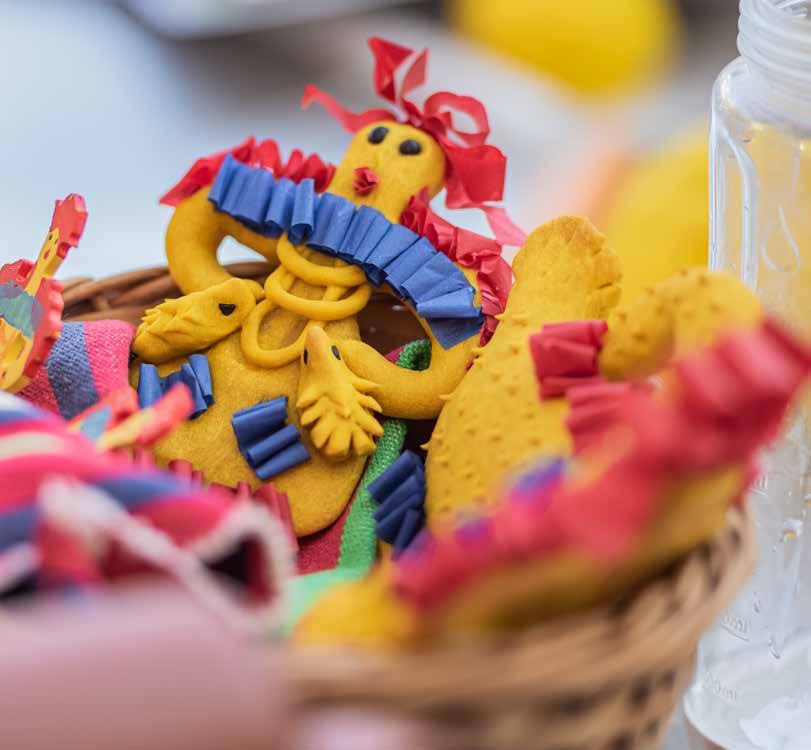


The table is never the same nor does the heart beat the same like on Christmas Day.
José António Gonçalves
Given the importance of the Christmas season in Madeira, Christmas is, for Madeirans, ‘The Festivities’. They reproduce their living reality in their nativity scene and lapinhas – nature, with its rocks and chasms, the water that flows in the levadas, the customs of religious and social life, the traditions.
The Christmas Festivities begin with the Childbirth Masses on 16 December and continues until January, with the sweeping of the cupboards of Santo Amaro on the 15th or, in some parishes of the island, the festivities of Santo Antão or São Sebastião on 17 and 20 January, respectively.
It’s at the Christmas Festivities that the table becomes abundant, that new clothes are worn and that socialising takes place, in the traditional act of ‘visiting the lapinhas’, tasting the biscuits and liqueurs, ‘and singing’ to Baby Jesus.
Christmas and New Year’s Eve are now Madeira’s main tourist attractions. From 1 December onwards, entertainment is constant: decorations and lights brighten up all the towns of Madeira and Porto Santo. Music fills city centres and the smell of meat seasoned with wine and garlic takes over the senses.
The programme is extensive and reveals the population’s strong religious side (especially the Childbirth Masses, one of Madeira and Porto Santo’s greatest Christmas traditions), as well as the cultural and artistic power fostered over decades, culminating in the famous fireworks display on 31 December, officially registered in the Guinness Book of Records as the world’s biggest spectacle.


The Madeiran table is made of land and sea. It’s made of tradition that the new times combined with modernity. The espetada (beef skewer on a laurel stick), the bolo do caco with garlic butter, the meat seasoned with wine and garlic, accompanied by fried corn or sweet potato are a delight for meat lovers. Closer to the land, the wheat soup, which contains everything the earth gives: cereals, vegetables, potatoes and anything else you want to throw into the pot. And the tropical fruits that the climate allows – bananas, custard apples, avocados, passion fruit. From the sea, limpets, swordfish fillet or tuna steak, accompanied by freshly fried corn, remind us that we are islands and that we have the sea at our feet.

To drink, the wines, as an aperitif, to accompany meals or as a digestif, paired with honey cake. And the ponchas, made with the honey from the sugar cane that made Madeira rich in the early days of settlement.
Madeirans establish the various moments that mark their gastronomy around the religious calendar. Tradition even notes a calendar for this ritual. The honey cake is made on 8 December. The pig is killed on 15 December, so that the sausages and the meat seasoned with wine and garlic are ready for Christmas. On the evening of the 24th, the meat is tasted on the way back from midnight mass. The table remains full of liqueurs, sweets and cakes,

much to the delight of inhabitants and visitors. Homemade chicken broth and roast meat with couscous completed the Christmas meal.
The religious calendar and the farming year set the rest. On Good Friday, the tradition is boiled yams; on São Martinho it’s codfish; and on St. John it’s salpresado (salt cured) tuna. At the festivals, however, there must be the espetada (beef skewer on a laurel stick), often accompanied by bread and potatoes that the meal basket kept for these moments.
Regarding Porto Santo, the current cuisine is also heir to the cultural tradition of the European settlers, the contributions of outsiders and maritime routes.
Porto Santo’s History records the consumption of herbs that grow in the fences: common sow thistle, lobster flower, chard, wild raddish, sourgrass, rock samphire, thistle, hedge mustard, celery. Some of these herbs are

still used in Porto Santo’s cuisine: rock samphire (chrithmum maritimum) that accompanies the fish on Good Friday and which was already used in escabeche at the time of the Discoveries in an attempt to prevent scurvy, and hedge mustard (erysimum officinale) that accompanies the escarpiada. It was this mixture of flour, water and salt, without yeast, baked on a clay stone that satisfied hunger in times of poverty.
You can’t miss the bolo-do-caco, the gaiado em escabeche or the lambecas, in the middle of the town.
The fruit refreshes the table in the Summer: grapes, melons, watermelons, blackberries and figs. Porto Santo’s confectionery include sponge cake, flour biscuits, bolo preto and capelas de S. João, which are still part of the gastronomy of Porto Santo today.



As a space open to the world, the Archipelago of Madeira has a vast cultural heritage, a very important inheritance that constitutes the roots of a people that for more than 600 years has related to itself, to others, to nature and to the supernatural. There are monuments, religious temples, museums and cultural spaces; there are legends, stories, songs, rituals, liturgies, ways of doing things, traditions; there dances, myths, beliefs and prayers. Material and immaterial heritage represents, i.e., makes present, the collective memory that identifies us as Porto Santo and Madeiran people.
Time is recognized in the architecture of the various periods that have been marked on the streets: examples of Manueline, Baroque and modern

architecture, churches and chapels that are extremely rich in paintings, jewellery, sculpture and furniture; forts and palaces that tell the stories of the Filipes and pirates, ‘quintas’ that have welcomed visitors from all over the world and museum spaces that are veritable vaults of beauty, wealth and, above all, life.
A look at just a few places of remembrance: the Cathedral, the Convent of Santa Clara, the Museum of Sacred Art, the churches that tell the story of our spirituality, the museums that keep the treasures of who we were and who we are. A look at the memories we build every day, in this encounter with the past, in this foundation for the future.





All you have left when you wake up The memory of beauty, That the towels you embroidered Trim bread from another table.
Irene Lucília Andrade
Art, in the hands of each people. Handicraft is usually born out of necessity and accompanies the place’s history, passing on know-how from generation to generation. This is one of the ways of transmitting the authenticity of culture, folklore and tradition.
In Madeira, botas de vilão and barretes de orelhas were very useful at a time when a large part of the population went barefoot and shepherds lived in the cold mountains. Meanwhile, other activities emerged, creating markets and offering young people the chance to innovate.
Today, there are many handicraft activities that combine tradition with modernity in Madeira: wickerwork, ceramics, embeddings, dough dolls,

miniatures, barretes de orelhas, corn straw dolls, brinquinhos, nativity scenes, botas de vilão, folklore costumes, etc. In Porto Santo, in addition to pottery and nativity scene figures, straw hats, basketry and palm hearts are used, especially at Easter time, in the Palm Day Procession.
However, embroidery stands out for its historical, economic and social importance. It is from the calloused hands of the women of Madeira that true works of art emerge. It was by the hand of the British, particularly Miss Phelps, that embroidery made its way from the island to the world and took our name abroad...

In this world beyond Madeira your name lives on
In your longing children
Who beyond borders
Show their pride of you.
Do Hino da Madeira
Over the years, Madeira has been a boarding pier, especially since the 19th century, with agricultural crises, vineyard disease and a great increase in taxes on everything. In the 20th century, there were wars, hunger, and the dreams of Brazil, Curaçao, South Africa, Venezuela, and so many other places...
Those who leave – and Madeirans populated the world – carry in their heart the longing and the promise of a return stamped on the portrait their mother keeps close to her chest and looks at every day when the sea (the sky, nowadays) doesn’t return those it took.
A place of possibilities and also of sacrifices, emigration has been, throughout Madeira’s history, an (often successful) attempt to belong to the world: from the Canary, Azores and Cape Verde islands, the Caribbean, Hawaii, England and the Channel Islands and elsewhere – South Africa; Canada and North America, Curaçao, Venezuela and Brazil, among others.
It is well known that there are Madeirans in prominent positions all over the world, whether in politics, business, science or culture.
In the beginning they took their work and their will, they took their braguinha and their joy; they took Madeira and its identity. Today, they continue to come and go. More prepared. Ready to face the challenges of the new times. Many have built empires abroad and when they return, they bring back what the island couldn’t give to those who stayed.
Madeira is a permanent place of departures and arrivals. There are many Madeirans around the world, and they take the island with them. When they arrive – because they know they will always have a home waiting for them – they bring homesickness wrapped up in those places where they’ve been and helped to build.
Today, the world comes to Madeira to live there. Consider the foreigners who came to live on the islands or the Digital Nomads who arrive, stay and enliven our communities.
Here, on these islands that belong to us, our doors are still open, the table is still set, and we have perfected the art of hospitality.
The mild climate and sweet air invite you to enjoy the outdoors all year round: a swim in the sea, a walk in the mountains, discovering the waterways that tear through the mountains, a paragliding or hang-gliding baptism, a cable car ride up Monte, a sledge’s vertigo, a boat trip to spot cetaceans or to discover the treasures that the ocean hides, a golf or tennis tournament, the peace and quiet of a simple life that allows you to invest in your health, experience the intensity of things, have fun and work.
This is the Region that Madeirans have to offer. This is the Region that Madeiran and Porto Santo people who live outside the islands’ walls want to offer: a place where it is possible to be happy.
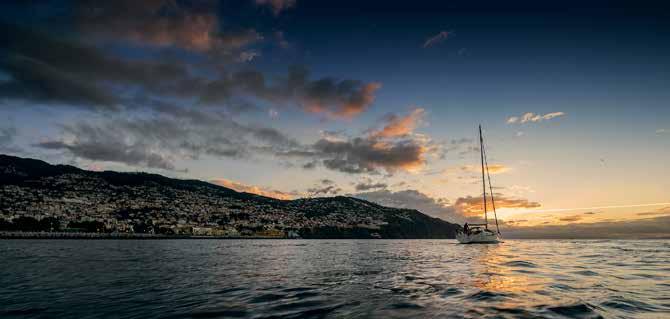


Events
People
1418-1419
Discovery of the islands of Madeira and Porto Santo by João Gonçalves Zarco, Tristão Vaz Teixeira and Bartolomeu Perestrelo 1425
Introduction of sugar cane cultivation

Casamento de Colombo com Filipa de Moniz, em Lisboa
1496
Foundation of the Santa Clara Convent in Funchal. Pope Alexander VI established regular observance and the beginning of the enclosure for this convent
1498
1420
Beginning of Madeira’s Settlement

1493
Grant of land in Campo do Duque to the Municipality of Funchal for the construction of the Cathedral
1446
Madeira is incorporated into the Crown 1480 ?
Donation of the captaincy of the island of Porto Santo to Bartolomeu Perestrelo
Passing of Columbus through Madeira on his third voyage to the Americas


1497
1501
King Manuel ends the granting of land as sesmaria. The only caveat was land that could be used for sugar cane fields and vineyards
1508
Elevation of the town of Funchal to the category of city

1523
Period of famine in Madeira
1533
Creation of the First Global Diocese (Funchal)
1552
Reference to the existence of banana trees in the island of Madeira, in a text by Thomas Nichols

1514
Creation of the diocese of Funchal
1503
The export of wood and timber is banned to prevent the progressive destruction of groves.
– King Manuel orders the expulsion of all Guanches from the Canary Islands, except the sugar masters
1530
In the 1530s, with the sugar crisis, sugar cane fields began to be replaced by vineyards

1550
French pirates raid Porto Santo
Beginning of the Jesuit College
1566
French pirates plunder Funchal and land at Formosa Beach 1599
1614
Beginning of the construction of the Fortress of S. Tiago

1650
Canon Henrique Calaça de Viveiros established the Nossa Senhora da Encarnação Convent
1668
Construction of the new Hospital in Largo da Sé

1692
Construction of the São Vicente Chapel at the river mouth
1629
Beginning of the construction of the Church of St John the Evangelist, known as the Colégio Church

1654
1656
Donation of the archipelago of Madeira by King João IV to his daughter, Infanta D. Catarina
Foundation of the Mercês Convent

1689
Construction of the Varadouros Arch, City Gates, later demolished in 1911
1748
Year when Álvaro Rodrigues de Azevedo, annotator of ‘Saudades da Terra’, marks the end of the sugar period in Madeira

1757
Famine in Madeira caused by the lack of bread. The potato had not yet been introduced, but there was already sweet potato
1762
Opening of the first pier to the islet of São José Fort, a work launched in 1756
1789
The Pillar of Banger is built to transport goods by crane between ships and land

1771
The Agriculture Regime insists on planting pine, juniper and chestnut trees in the mountains of Porto Santo and mulberry and hawthorn trees near the cultivated areas
1799
Installation of a plant nursery in the parish of Monte
1755
1760
Introduction of potato (semilha) cultivation in Madeira
Tsunami which resulted in the island of Porto Santo receding by about a hundred metres
1773
Only 200 families owned all the farms on the island, while at the same time there were around 6,000 estates and chapels
1764
Sugar cane fields disappeared from Santa Cruz and Machico, and were replaced by wheat, wine and barley

1794
Construction of the first wine greenhouse in Madeira
1800
Potato, yam and corn dethroned the hegemony of cereals in the diet. Maize dominated the diet at the beginning of the century
1803
Establishment of the Festival of Nossa Senhora do Monte as Funchal’s patron saint
– Floods in Funchal and Machico

1807
British troops occupy Madeira for the 2nd time
1821
Official proclamation in Madeira of the triumph of the Liberal Revolution that took place in Porto on 24 August 1820
1837
Creation of the MedicalSurgical School of Funchal
1854
Severiano Ferraz proposes replacing vineyards with sugar cane

1801
1st occupation of the island by British troops
1815
Napoleon Bonaparte passes through Madeira on his way to exile at Santa Helena

1804
Brigadier Reinaldo Oudinot is in charge of studying and implementing the works to protect Funchal’s streams
1821
The first Madeiran newspaper, Patriota Funchalense, was printed on 2 July 1821. The newspaper, the first in the Portuguese islands’ world, was published weekly and was founded by doctor Nicolau Caetano Bettencourt Pita

1870
In the 1870s and 1880s, maize was the basis of the diet of the poorest population
– Completion of the construction of the Levada do Rabaçal, that begun in 1835
1897
Inauguration of the first electric lighting in the city of Funchal, by The Madeira Electric Lighting company 1856-1859

Construction of the Princess Maria Amélia Hospice 1855
1863
Extinction of the manor houses
1890
The port of Funchal grows as far as the N. S. Conceição fort

During the construction of the Levada do Rabaçal, the water crossed the Estrebarias tunnel for the first time, passing from the north to the south of the island to fertilise vast plots of land that remained uncultivated

1884 – 1887
Construction of the D. Maria Pia Theatre, now the Baltazar Dias Theatre
1893
Inauguration of the first section of the Monte railway, between Pombal and Santa Luzia
1889–1892
Construction of the first section of the Funchal pier. Its extension was completed in 1933

1901
Decree granting autonomy to the archipelago of Madeira
– King Carlos and Queen Maria Amélia of Orleans arrive in Madeira

1910
Extinction of the Medical-Surgical School of Madeira
1917
World War I (The city of Funchal is bombed by a German submarine)
1931
Creation of Funchal’s District Archive.
– Flour Uprising.
– Madeira Uprising

1936
Milk Uprising
1912
Architect Ventura Terra draws up a plan to modernise the city of Funchal. The document dictated the guidelines for the city’s urban development in the 20th century

1904
First car in Funchal, belonging to Harvey Foster
1929
Start of the construction work on the Porto Santo pier-bridge

1921
1st Lisbon-Funchal flight in a hydroplane by Gago Coutinho and Sacadura Cabral
1939
Opening of the current Avenida do Mar to the public
1934
Inauguration of the monument to João Gonçalves Zarco in the city of Funchal
1940
Inauguration of the Mercado dos Lavradores (Farmers’ Market)

– First statute of the autonomous districts of the adjacent islands
– Around 4,000 British residents of Gibraltar take refuge in Funchal
– Inauguration of the Dr. João Francisco de Almada Sanatorium
1947
The final status of the autonomous districts of the islands, which remained unchanged until April 25, 19744
1943
Last journey and closure of the Monte Railway Track

1950
1955
Inauguration of the Diocesan Museum of Sacred Art
1957
Inauguration of the Barreiros Stadium

1964
Inauguration of the Funchal airport

1960
Inauguration of the Porto Santo airport
Winston Churchill’s visit to Madeira
Porto Santo:
– Start of home drinking water distribution
– Inauguration of the Power Station
1971
1972
First television broadcast in Madeira
Creation of the Selvagens Islands Reserve
1973
Inauguration of the Cruz de Carvalho Hospital, currently Dr. Nélio Mendonça Hospital

1976
1981
Creation of the Madeira Natural Park
1988
The installation commission of the University of Madeira takes office
1991
Pope John Paul II visits Madeira

1985
Creation of the Atlantic History Studies Centre
The 1st Regional Government takes office
1989
Start of construction work of the Ribeira Brava - Caniçal motorway, completed in 2005

1999
The Laurissilva Forest becomes a UNESCO World Heritage Site
2000
Inauguration of the extension works of Madeira International Airport

2004
Inauguration of Caniçal’s commercial port
– Inauguration of Casa das Mudas, Calheta
– Beatification of Emperor Charles of Austria
– Madeira receives the European Region 2004 award
2013
Madeira is voted Europe’s Best Island Destination for the 1st time
2017
Madeira Airport becomes associated with the name of Madeiran footballer Cristiano Ronaldo
2022
Restoration of the Mudejar ceilings of the Funchal Cathedral
2023
Reopening and musealisation of the Santa Clara Convent, after rehabilitation of the building and restoration of its collection
2002
Inauguration of Madeira International Airport’s terminal

2010
Inauguration of the Maritime Station of the Port of Funchal
– Funchal enters the Guinness World Records for the world’s biggest pyrotechnic show
– Madeira integrates the Seven Natural Wonders of Portugal
2015
2019
Pope Francis appoints José Tolentino Mendonça Cardinal
Madeira is voted World’s Best Island Destination for the 1st time
– Inauguration of the Contemporary Art Museum at Casa das Mudas

2024
Best year ever for tourism in Madeira (to date)
Multimedia
Madeira – The Perfect Spot by Joffrey Vandenbussch
Tourist Entertainment
Annual tourism and cultural events promoted by the Regional Government of Madeira
Gastronomy
MOT – Madeira Ocean & Trails
– Active tourism
Cultural offer
Biqueira Project
Madeira’s Classical Orchestra
Cultural Agenda
Organ Festival


Madeira Destination
Madeira Brand
Awards and Distinctions
Calendar Events
Photobank – Madeira and Porto Santo
Tourism Promotional Materials – Maps, Publications and Event Guides
Website – Madeira Sustainable for all
13 visitmadeira.com homepage
17 Passionate about Culture – visitmadeira.com
28 History of Madeira – visitmadeira.com
32 Laurissilva Forest – visitmadeira.com
36 Walks in Madeira – visitmadeira.com
42 Madeira’s Sea – visitmadeira.com
46 Beaches in Madeira – visitmadeira.com
49 Porto Santo Beach – visitmadeira.com
53 Experiencing the city of Funchal – visitmadeira.com
54 Exploring the City – visitmadeira.com
60 Porto Santo – visitmadeira.com
77 Distinguished Visitors in Madeira -Work
82 Events Programme – visitmadeira.com
89 Christmas and New Year Festivities – visitmadeira.com
95 Gastronomy in Madeira – visitmadeira.com
98 Madeira Heritage – visitmadeira.com
99 Churches in Madeira – visitmadeira.com
105 Madeira Crafts – visitmadeira.com
106 Madeirans in the World
107 Digital Nomads Madeira Islands homepage
Back cover ‘Enchanted’
Online edition in Portuguese, English, French and German
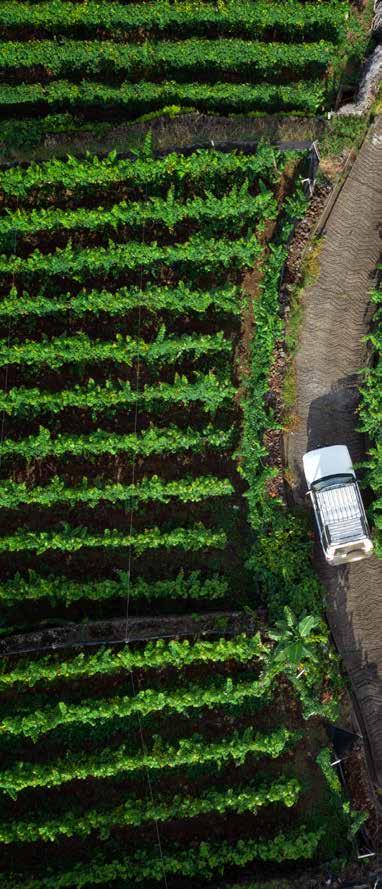

Places that belong to us
The History
The Forest
Levadas - Waterways
The Sea 45 Beach - Where the Land meets the Sea
Funchal: The Capital 57 (Other) Places
Madeira’s Economy
Porto Santo’s Economy 73 The people of the islands
From outside
Always Celebrating 85 Pilgrimages and Festivals 89 The (Christmas) Festivities
Gastronomy - Eating the land and the sea
Cultural Heritage 103 Handicraft - The art of (our) hands
Madeirans in the World
And here...
Timeline 122 QR-Codes List - Madeira and Porto Santo Destination
Technical Information
Title Enchanted
Editor Madeira Promotion Bureau
Coordinator Eduardo Jesus
Text Graça Alves
Translation AP | PORTUGAL Tech Language Solutions
Support Cora Teixeira and Francisco Correia
Photography Carlos Gouveia
Duarte Sol
Francisco Correia
Henrique Seruca
Miguel Moniz
Nuno Rodrigues
Ricardo Faria Paulino
IVBAM
Regional Directorate of Archives, Libraries, and Book
Madeira Photography Museum - Atelier Vicentes
Regional Directorate for Culture
Cover photo Vereda dos Balcões, by Francisco Correia
Design and Layout Gonçalo Mendes
Print GRAFISLAB – Packaging Solutions
Legal Deposit 534584/24
Location Funchal

